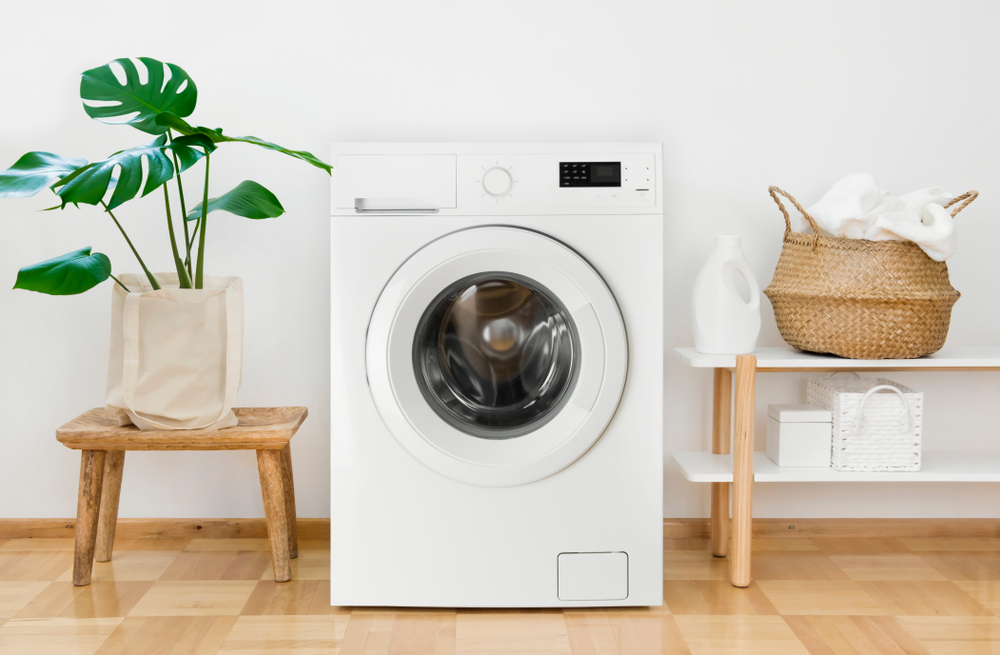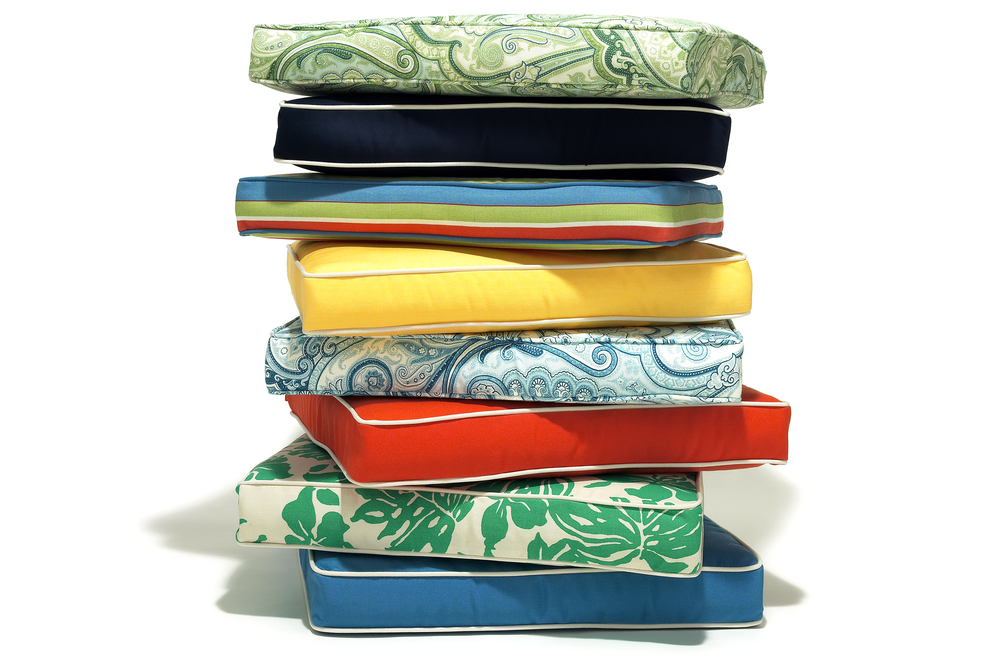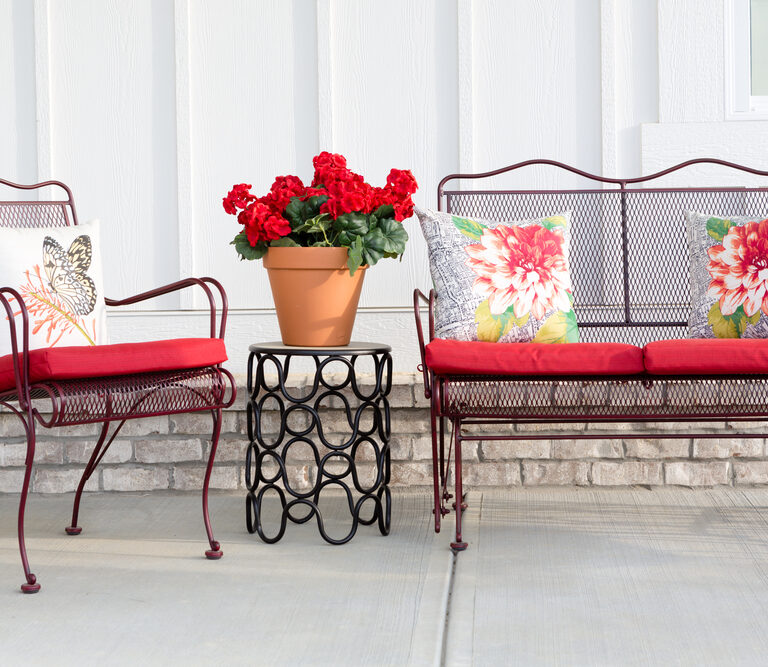Outdoor cushions go through a lot: they get caught in inclement weather, pooped on by birds, and often have dust, dirt, and debris like leaves and sticks blown onto them by the wind. Not only that, but they also suffer spills and oily sunscreen at the hands of us humans.
When the weather is nice, there’s nothing better than enjoying time outdoors with family and friends. However, in order to fully enjoy these things we need our cushions to be clean. No one wants to sit on a dirty seat, and we definitely wouldn’t expect our guests to do so.
Therefore, we’re going to share the best methods for how to clean outdoor cushions. Depending on your cushions and the tools you have available to you, there are a few different approaches you can take: machine-washing, hand-washing, pressure-washing, and spot-cleaning.
Machine-Washing Outdoor Cushions

Some cushions or their casings may be machine washable. To find out, check the tags to see if they have any care instructions and follow them.
In many cases, the casings to the cushions are machine washable but the cushions themselves are not. If you want to wash the cushions too, check out our next two sections on handwashing and power washing.
As far as the casings go, even if they are dryer safe you should not fully dry them. If you do, they may lose their shape and it’ll be a lot harder to put them back onto your cushions. Instead, let them dry until they are just a little damp and put them onto your cushions. Stand the cushions up on their sides to finish drying.
If your cushions have any stains, you can use products like Shout stain remover before putting them into the wash. You can also put some Borax into the washing machine along with detergent (follow the instructions on the box to determine how much to use).
How to Hand-Wash Outdoor Cushions
If your cushions and/or their casings cannot be thrown in the washing machine, then you’ll have to do it by hand. Obviously, this is more work than throwing something in the washer, but the process is easier than you might think. Be sure to wash your cushions on a driveway or sidewalk to avoid mud or grass stains.
Step 1: Vacuum Your Cushions
Before washing your cushions, it’s important to make sure you get any dirt or debris off of them first. Grabbing a vacuum cleaner is the most efficient way to do this, but you can also shake your cushions off if need be.
Step 2: Make Your Cleaning Solution
Now, it’s time to prepare your cleaning solution so that it’s ready when you need it. To make this solution, combine 1 tsp of dish soap, 1 tsp of Borax, and 1 qt of warm water.
Step 3: Rinse Your Cushions
Before you use your solution, you want to rinse off your cushions first. Set your hose to its highest power so you can rinse off anything the vacuum may have missed (like crusted on bird poop). You want your cushions to be wet but not completely soaked through.
Step 4: Scrub, Scrub, Scrub
Take a brush and dip it in your cleaning solution. Now, scrub your cushions so that the solution spreads across the entire surface and leaves a soapy lather. Don’t be afraid to put some extra elbow grease into any stained areas. Then, let the solution sit on the cushions for at least five minutes.
If your cushions are especially dirty or stained, you may want to let them sit even longer. Just make sure you don’t let them sit so long that they dry. You can also put extra solution on spots to help get them out.
Step 5: Rinse and Dry
Once your cushions have sat for at least five minutes, you can rinse them off. Again, you’ll want to have your hose set at the highest pressure possible for more cleaning power.
Finally, dry off your cushions. We recommend wrapping them in a towel and stepping on them as this will squeeze out the most moisture. After you’ve removed as much water as you can, stand them up on their sides so that they’ll dry faster. If you can, place them in a sunny area.
How to Pressure-Wash Outdoor Cushions
Before pressure washing your cushions you’ll want to be sure to read any care instructions provided. Even though these cushions are manufactured to withstand the outdoors, they aren’t necessarily made to handle something as powerful as a pressure washer.
There is a possibility that you could damage the fabric or break the seams of the cushions. If you think your cushions can handle it, then pressure washing is certainly a quick and easy way to go about cleaning them. As before, be sure to clean your cushions on a driveway or deck to avoid mud and grass stains.
Step 1: Set Up Your Pressure Washer
If you already have a pressure washer then you probably know how to use it; we won’t waste your time with an explanation. All you need to do is set up your pressure washer with your preferred cleaning solution (you can use the same solution from the previous section.
Set the pressure washer to its lowest setting to reduce the likelihood of damaging the cushions’ seams. Do a couple of test sprays on your driveway before getting started.
Step 2: Spray Your Cushions
Spray your cushions with the power washer, making sure that you’re not getting too close to them. Keeping a bit of distance along with keeping the pressure at its lowest will help you avoid damaging the fabric.
Step 3: Scrub
If your cushions are really dirty, it can be helpful to use a brush to further scrub the solution into them. You’ll want to give extra attention to any stains. Leave the solution to sit for at least five minutes.
Step 4: Rinse and Dry
Finally, you can rinse your cushions off and leave them to dry. We suggest using a towel to squeeze the moisture out of them (wrapping them in the towel and then stepping on them works great).
Once you’ve gotten as much moisture out of them as possible, stand them on their sides to dry. Put them in a sunny area to speed up the process if you can.
Spot-Cleaning Outdoor Cushions

There are certain types of spots and stains that may need a little extra love. We’re going to tell you how to remove each type of unwanted stain that your cushions may be suffering from.
Removing Bird Poop
Since your cushions live outdoors, they’re bound to get bird poop on them. If you can, it’s best to wait until the poop is dry because it can be removed much more easily. Once it’s dry, you can scrape it off with a stiff-bristled brush.
If the droppings are still wet, scrape them off with a butter knife or credit card. You don’t want to rub them in any further.
Then, use the same cleaning solution we mentioned before borax, dish soap, and water to treat the spot. Let it sit for five minutes and rinse it off.
Oil Stains
Oil stains may be a result of sunscreen, bug spray, or spilled food. The cause itself doesn’t matter all that much, though; you just need to know how to get it out.
To remove these stains, grab some corn starch or baking soda — whatever you have readily available. Blot the stain with a microfiber cloth to remove excess oil, and then pour some cornstarch onto it.
Let this sit for 15 to 20 minutes. Scrape off the excess cornstarch and you should be good to go.
Mold and Mildew
Mold and mildew grow in damp conditions, which is why it’s important to keep your cushions out of the rain (or stand them up to dry if they do get soaked). If your cushions have mold and mildew on them, you have a few options for cleaning them.
You can use four parts Borax to one part water or, if you want something a little stronger, a one-to-one ratio of Oxiclean and water. A one-to-one ratio of hydrogen peroxide and water will also work.
For especially resistant mold and mildew, try a tablespoon of bleach in a pint of warm water. Make sure to test your cushions for colorfastness before applying this to the stain, or you may end up with an ugly bleach spot on your cushion.
Once you’ve chosen your poison, brush off as much mold and mildew as you can. Then, apply the solution using a microfiber cloth, sponge, or spray bottle. Allow it to sit for 15-20 minutes before blotting out the mold stains with a cloth. Finally, rinse your cushion and leave it to dry.
Tree Sap
Tree sap can be a pain to remove from your cushions, but it isn’t impossible. Before going all out with this method, test a hidden area of your cushion for colorfastness since our cleaning product of choice is nail polish remover (acetone).
First, scrape off any dried tree sap with a knife. Then grab some acetone and wet part of a cloth with it. Hold this on the sap until it softens enough that you can wipe it away. You can then use some soapy water to wash the area and make sure there is no residue left behind.
Prevention
While you’ll probably have to wash your cushions at least once a year, there are a number of things you can do to protect your cushions from getting dirty. Here are some of the things you can do to keep your cushions looking fresher for longer.
- Put your cushions away when they aren’t being used.
- Use a spray protectant like Scotchgard Water Sun Shield.
- If your pillows get wet, place them on their sides to help them dry faster.
- Clean up spills immediately; the longer a stain sets the harder it is to get out.
- Regularly clean off dirt and debris with a vacuum or a brush.
- Rotate your cushions so that the same cushions won’t always be in the shade or always in the sun.
There’s Nothing Better Than Clean Cushions
To clean your outdoor cushions you don’t need any expensive products. All you need is a hose, your cleaning solution (Borax, dish soap, and water), and a scrub brush. If you have a tool like a power washer, you can certainly use it to speed up the process. However, be careful not to damage your cushions by holding the pressure washer too close.
Once your cushions are clean, be sure to spray them with water and sun protectant. Brush or vacuum off dirt and dust regularly to keep them clean. If you have space, you can even stow the cushions in a garage or shed when they’re no being used.
Maintaining your cushions means you won’t have to clean them as often, so it’s worth your time. Less time cleaning means more time enjoying lovely weather.
